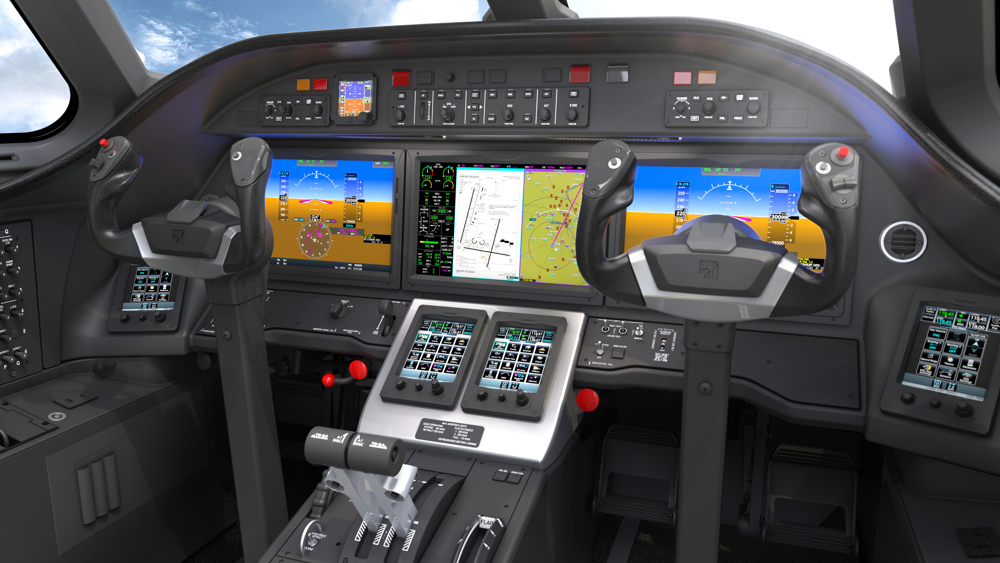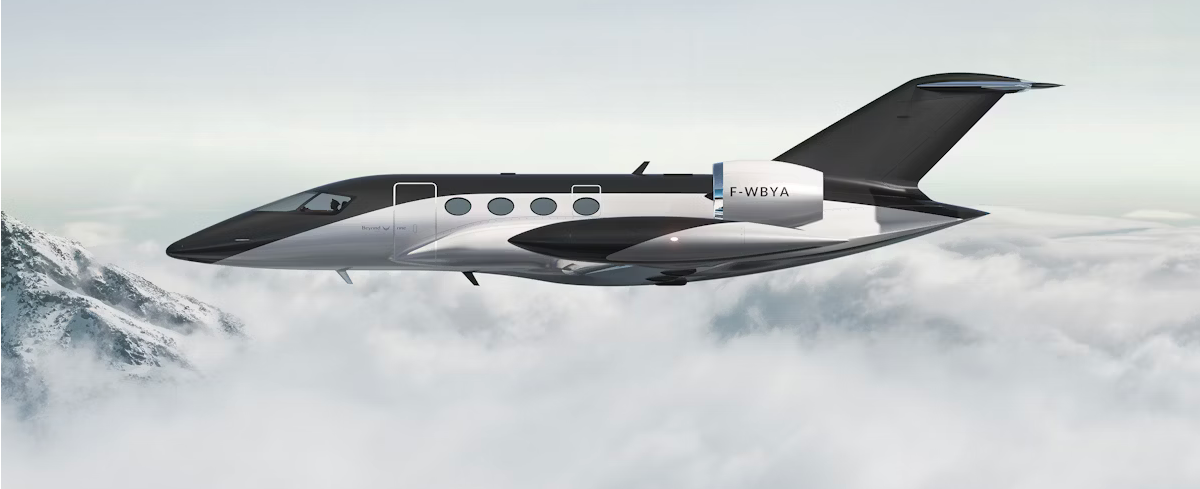How Operators Shaped the Citation Ascend
Textron built the Citation Ascend on direct feedback from Citation operators rather than internal engineering priorities. Two flight test aircraft completed over 1,000 flight hours and passed certification tests that validated operator requests for improved cockpit integration, reduced pilot workload, and enhanced passenger comfort.
Chris Hearne, Textron's Senior Vice President of Engineering & Programs, described the approach: “We sought our customers’ feedback, and the result is a business jet that offers customers the latest innovations in performance, productivity, and efficiency".
Operators told Textron they wanted autothrottle technology, larger displays with split-screen capability, synthetic vision supporting lower approach minima, and a flat-floor cabin with modern connectivity. Textron integrated Garmin G5000 avionics with factory-installed autothrottle, three 14-inch displays, Synthetic Vision Technology with SVGS, and a redesigned cabin with 19 USB ports, wireless charging, and optional Gogo Galileo HDX connectivity.
NetJets confirmed it will launch the Citation Ascend into fractional operations, continuing a partnership with Textron spanning multiple Citation models. Your flight department gains access to proven Citation DNA updated with technology operators requested rather than features marketing departments imagined.
Garmin G5000 Avionics Transform Cockpit Operations
 Cessna Citation Ascend Cockpit
Cessna Citation Ascend Cockpit
Textron equipped the Citation Ascend with Garmin G5000 avionics, incorporating the software update announced at NBAA-BACE 2024. Earlier Citation 560XL variants used Primus 1000 or Pro Line 21 systems that required pilots to cross-check separate instruments for navigation, communication, and performance monitoring. The G5000 consolidates these functions into three 14-inch ultra high-resolution displays with split-screen capabilities:
| Feature | Operational Impact |
| Autothrottle | Manages power settings automatically and protects flight envelope limits |
| Display System | Three 14-inch displays with split-screen reduce pilot scan time and improve situational awareness |
| Navigation | Dual flight management systems provide redundancy for oceanic and domestic operations |
| Terrain Awareness | Synthetic Vision Technology with SVGS supports approach minima as low as 150 feet |
| Connectivity | Cockpit voice and data satellite transceiver enables satellite calls during flight |
| Weather | Garmin weather detection and avoidance technology improves flight planning accuracy |
| Extended Range | Optional second Iridium data radio and CPDLC provides more direct transatlantic routing |
If you operate Citation 560XL, XLS, or XLS+ aircraft, the Citation Ascend eliminates the workflow burden of managing fragmented instruments. Autothrottle manages engine power automatically while protecting flight envelope limits, freeing you to focus on navigation and communication during critical phases of flight. The G5000 displays all crucial information on three integrated screens, reducing scan time and pilot fatigue on long flights.
Performance Specifications and Operating Economics
Pratt & Whitney Canada PW545D engines power the Citation Ascend. The engines incorporate FADEC technology, enabling the autothrottle system while improving compressor and turbine efficiency to lower fuel burn and operating temperatures:
| Specification | Value |
| Maximum Speed | 441 knots true airspeed (817 km/h) |
| Maximum Range | 1,940 nautical miles (3,593 km) |
| Full Fuel Payload | 900 lbs (408 kg) |
| Time Between Overhaul | Approximately 6,000 hours |
The Honeywell RE100XL Auxiliary Power Unit operates unattended with self-management and bleed leak detection. You heat or cool your cabin before flight without running main engines, reducing fuel consumption and ramp noise. Extended maintenance intervals lower your direct operating costs compared to earlier 560XL variants.
 Cessna Ascend Interior
Cessna Ascend Interior
The cabin features a flat floor, 15% larger windows, improved acoustic insulation, and wireless controls for lighting, temperature, and shades. Passengers have access to 19 USB ports, three universal outlets, wireless charging, and optional Bongiovi immersive audio. Standard Gogo Avance L3 Max connectivity upgrades to L5 or global Galileo HDX. The flat floor matters for operators moving between business configurations and special mission applications requiring equipment installation or wheelchair accessibility.
Where the Citation Ascend Fits Your Mission Profile
The midsize business jet market offers distinct operational profiles. Your purchase decision depends on mission requirements, pilot familiarity, and total cost of ownership. The following comparison shows how the Citation Ascend positions against current competitors:
| Aircraft | Max Speed (ktas) | Max Range (nm) | Full Fuel Payload (lbs) | Service Ceiling (ft) | Passenger Capacity | Avionics |
| Citation Ascend | 441 | 1,940 | 900 | Not specified | Up to 12 | Garmin G5000 |
| Embraer Praetor 500 | 466 | 3,340 | 2,921 | 45,000 | 8-9 | Pro Line Fusion |
| Learjet 75 Liberty | 465 | 2,080 | 2,450 | 51,000 | 6 | Garmin G5000 |
| Citation Latitude | 446 | 2,678 | 2,544 | 45,000 | 9 | Garmin G5000 |
| Hawker 900XP | 452 | 2,825 | 1,950 | 41,000 | 8-9 | Collins Pro Line 21 |
The Embraer Praetor 500 delivers 3,340 nautical miles of range with 2,921 pounds of payload, optimizing for transcontinental missions requiring extended range and cargo capacity. This matters when you fly coast-to-coast with full passenger loads and significant baggage or equipment. The Learjet 75 Liberty climbs to 51,000 feet and matches the Praetor 500 on speed at 465 knots, but limits cabin capacity to six passengers. You choose the Learjet 75 Liberty for high-altitude capability and speed when passenger count matters less than time efficiency.
The Citation Latitude provides 2,678 nautical miles of range with nine-passenger capacity and shares the Garmin G5000 avionics platform with the Citation Ascend. The Latitude serves operators requiring a greater range than the Citation Ascend provides while maintaining Garmin G5000 commonality for pilot training. The Hawker 900XP offers 2,825 nautical miles of range equipped with Collins Pro Line 21 avionics. The Hawker 900XP serves operators prioritizing range over modern avionics integration.
The Citation Ascend prioritizes incremental improvement over revolutionary change. If your flight department operates Citation 560XL, XLS, or XLS+ aircraft, your pilots transition to the Citation Ascend without relearning aircraft handling characteristics. You gain Garmin G5000 avionics, improved fuel efficiency through PW545D engines, and enhanced passenger comfort while maintaining operational familiarity. For missions prioritizing short- to medium-range efficiency, with factory-installed autothrottle technology and flat-floor cabin flexibility, the Citation Ascend addresses your operational requirements. A Citation 560XL series aircraft takes off or lands somewhere in the world every minute. The Citation Ascend updates this foundation for operators who need modern avionics and extended maintenance intervals without abandoning the operational characteristics that made the family successful.
Why the Citation Ascend Matters for Business Aviation
Textron Aviation has delivered over 1,000 Citation 560XL series aircraft since 2000. Operators choose the platform for its combination of performance, comfort, operational simplicity, and favorable cost structure. The Citation Ascend modernizes this foundation with Garmin G5000 avionics, PW545D engines with autothrottle, and a redesigned cabin that addresses specific operator feedback. Business aviation continues to integrate sophisticated avionics, improve engine efficiency to reduce environmental impact, and enhance passenger and crew experience. The Citation Ascend advances Textron’s product line while addressing operator demands for platforms that balance proven reliability with current technology.
Frequently Asked Questions About the Citation Ascend
When does the Citation Ascend enter service? Textron Aviation expects to begin deliveries before the end of 2025, with customer aircraft already in preparation.
How does the Citation Ascend differ from the Citation XLS+? The Citation Ascend features Garmin G5000 avionics (the XLS+ used Pro Line 21), factory-installed autothrottle, PW545D engines (the XLS+ used PW545C), Honeywell RE100XL APU, flat-floor cabin, 15% larger windows, and 100-pound higher full-fuel payload.
How many passengers does the Citation Ascend accommodate? The aircraft accommodates up to 12 passengers, depending on interior configuration.
What connectivity options does the Citation Ascend offer? Standard equipment includes Gogo Avance L3 Max. Operators upgrade to Gogo Avance L5 or global Galileo HDX connectivity.
Does the Citation Ascend qualify as part of Low-Altitude Economy operations? No. The Citation Ascend operates as a conventional business jet for corporate, charter, and fractional operations. It does not participate in urban air mobility, drone deliveries, or air taxi operations that define Low-Altitude Economy activities.
Appendix: Certification Timing and Government Shutdown Context
The FAA approved the Citation Ascend type certificate on November 5, 2025, during a government shutdown that began on October 1. The certification was completed in a multi-year development program that reached technical conclusion before the funding lapse.
Flight testing began in 2023. Two test articles logged over 1,000 hours before certification. The first production unit rolled out in September 2025. Aircraft certifications spanning multiple years with substantial pre-shutdown completion typically proceed through administrative approval stages. Essential FAA personnel continue working on critical safety functions during funding lapses.
The broader aviation system faced a crisis during this period. On November 5, the FAA announced 10% reductions in traffic at 40 major airports due to severe staffing shortages among air traffic controllers. Controllers worked without pay. Thousands of aviation safety positions remained unfilled. System-wide service degradation generated controversy, not the completion of a single aircraft certification planned years earlier.




